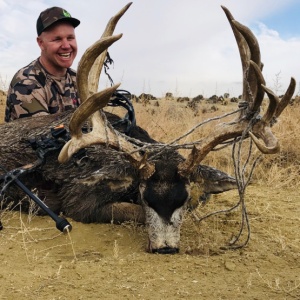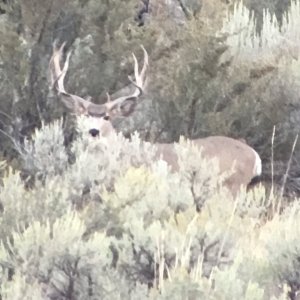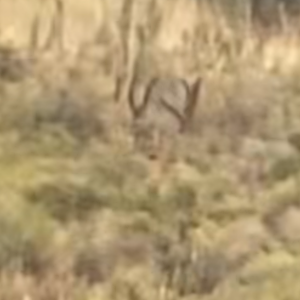I am biting my tongue trying not to rip on this ummmm, judge.
Judge restores wolf protections
By EVE BYRON - Independent Record - 07/19/08
AP file photo/U.S. Fish & Wildlife Service, File - A federal judge in Montana has ordered gray wolves in the Northern Rockies be returned to the endangered species list. U.S. District Judge Donald Molloy granted a preliminary injunction Friday restoring federal protections for the wolves. Gray wolves once again are under the protection of the Endangered Species Act, after federal court Judge Donald Molloy ruled late Friday that state management plans in Montana, Idaho and Wyoming will irreparably harm the species? reintroduction.
In particular, in his 40-page decision the judge pointed toward the 1994 reintroduction document that discussed the need for genetic diversity among the wolf populations. Molloy said genetic testing of wolves in Yellowstone National Park, where wolves were reintroduced in 1995, showed that few if any new wolves were moving into the area from northern Montana and Idaho. He and others fear that low genetic diversity will lead to inbreeding that will diminish reproduction.
?Dispersal between the Great Yellowstone core recovery area and the northwestern Montana and central Idaho recovery area ? a precondition to genetic exchange ? is rare,? the judge wrote. ?Only four to 12 wolves have dispersed beyond the core recovery areas in the 13 years since wolves were reintroduced.
?The reduction in numbers that will occur, based on wolf hunts and state depredation control laws, will lessen the population making genetic exchange less likely.?
Molloy added that the federal government seemed to be casting its earlier genetic diversity argument aside in its delisting decision earlier this year and focused instead on wolf population numbers as one of the main criteria. He noted that in the 1994 document, the federal government warned against doing so.
Wolf numbers have multiplied much quicker than what initially was expected, with more than 1,500 wolves in the northern Rocky Mountains.
Molloy could lift the injunction if the defendants in the case, including federal and state agencies, prove to the judge that Montana, Wyoming and Idaho have sufficient safeguards in place to perpetuate wolf populations.
Representatives from some of the 12 conservation groups that filed the lawsuit seeking to reverse the gray wolf?s removal from the list of threatened or endangered species applauded Molloy?s decision.
?This injunction is necessary to prevent the states from implementing management schemes that have the primary purpose of eliminating, rather than conserving, wolves,? said Michael Garrity, executive director of the Helena-based Alliance for the Wild Rockies.
Michael Robinson of the Center for Biological Diversity in New Mexico added that the injunction will ?give wolves a fighting chance.?
?Recovery requires allowing wolves in different populations to reach each other in order to mate and raise their pups,? Robinson said. ?Even before they were unlawfully removed from the endangered species list, the government was gunning down so many wolves that the Yellowstone population was reproductively isolated, a recipe for extinction.?
Suzanne Asha Stone, northern Rockies wolf conservation specialist for Defenders of Wildlife, added that this is an important first step, since it ?stops the continued and almost indiscriminate killing of wolves under the states? management plans that could have put the long-term recovery of the wolf at risk.?
She said they'll continue to work with others to improve state plans to maintain a healthy wolf population.
Ed Bangs, who handled the reintroduction of wolves for the U.S. Fish and Wildlife Service, and Carolyn Sime, Montana Fish, Wildlife and Parks statewide wolf coordinator, said on Friday that they're disappointed with the judge?s ruling but their agencies will respect it.
?You have to remember that with requests for injunctions, the courts tend to lean in favor of the endangered species issues,? Bangs said. ?Judge Molloy hasn't looked at the administrative record yet, so he doesn't know the background reasoning for our decision on delisting; he just knows what people are arguing.
?A lot of stuff, I think, will get resolved when he looks at the full merits of the case. In the meantime, Montana has been in charge of wolf management for four years already, and has been doing a good job, and will continue to do so.?
He said the study the judge relied on when making his decision regarding genetic diversity only looked at Yellowstone Park, and not the areas outside of it. Banks said Yellowstone has pretty much reached its wolf capacity, so they're moving out instead of moving in, and the study doesn't reflect that.
?And even if Yellowstone is isolated, there are no genetic problems, and on top of that, we'll have to point out that we said if there is a problem, we can always move wolves in there to fix that,? Bangs added.
Studies also show that the northern Rocky Mountain wolf population has increased at a rate of 24 percent annually even while experiencing 26 percent mortality.
Ironically, Sime was at a meeting in Helena Friday night, taking public comment on a proposal to reclassify wolves from a state endangered species to one in need of management, when she heard about the judge?s ruling. As part of that management, the state was considering instituting a wolf hunting season this fall. Those plans are effectively on hold, as are the ones to reclassify wolves in the state.
?We decided to proceed with the hearing since we had some folks turn out anyway,? Sime said. ?In some respects I guess the issue is moot ... wolves are now considered endangered in the northern half of Montana and an experimental population in the southern half.?
Wolves were put on the Endangered Species Act list in 1973 after being hunted to near extinction in the lower 48 states. But reintroduction and recovery work started in 1995 have burgeoned their population.
Montana?s management plan calls for a minimum population of 100 wolves with at least 15 breeding pairs. Montana currently has about triple that number.
Molloy also took umbrage with Wyoming?s management plan, noting that it listed wolves as ?predatory? species in 90 percent of the state, which would generally allow for them to be shot on sight. He noted that the federal Fish and Wildlife Service approved Wyoming?s wolf management plan in 2007, but it suffered from the same deficiencies that caused the agency to reject it the 2003 plan.
?In supporting its decision to approve Wyoming?s 2007 plan, the Service does not offer any information not available to it when it rejected the 2003 plan. Armed with the same information, the agency flip-flopped without explanation,? Molloy wrote. ?While the Fish & Wildlife Service can change its recovery criteria, it must nevertheless provide a reasoned analysis for the change of position and if it does so, its decision is entitled to deference. The Service has failed to do so here. Thus, in my view, Plaintiffs are likely to succeed on several of their claims.?
Molloy added that this case, ?like a cloud larger than a man?s hand, will hang over the northwest states of Montana, Idaho, and Wyoming until there has been a final determination of the complex issues presented.?
Other plaintiffs include Defenders of Wildlife, the Natural Resources Defense Council, the Sierra Club, the Humane Society, the Center for Biological Diversity, the Jackson Hole Conservation Alliance, the Friends of the Clearwater, Oregon Wild, the Cascadia Wildlands Project, Western Watersheds Project and the Wildlands Project.
Reporter Eve Byron: 447-4076 or [email protected]
Judge restores wolf protections
By EVE BYRON - Independent Record - 07/19/08
AP file photo/U.S. Fish & Wildlife Service, File - A federal judge in Montana has ordered gray wolves in the Northern Rockies be returned to the endangered species list. U.S. District Judge Donald Molloy granted a preliminary injunction Friday restoring federal protections for the wolves. Gray wolves once again are under the protection of the Endangered Species Act, after federal court Judge Donald Molloy ruled late Friday that state management plans in Montana, Idaho and Wyoming will irreparably harm the species? reintroduction.
In particular, in his 40-page decision the judge pointed toward the 1994 reintroduction document that discussed the need for genetic diversity among the wolf populations. Molloy said genetic testing of wolves in Yellowstone National Park, where wolves were reintroduced in 1995, showed that few if any new wolves were moving into the area from northern Montana and Idaho. He and others fear that low genetic diversity will lead to inbreeding that will diminish reproduction.
?Dispersal between the Great Yellowstone core recovery area and the northwestern Montana and central Idaho recovery area ? a precondition to genetic exchange ? is rare,? the judge wrote. ?Only four to 12 wolves have dispersed beyond the core recovery areas in the 13 years since wolves were reintroduced.
?The reduction in numbers that will occur, based on wolf hunts and state depredation control laws, will lessen the population making genetic exchange less likely.?
Molloy added that the federal government seemed to be casting its earlier genetic diversity argument aside in its delisting decision earlier this year and focused instead on wolf population numbers as one of the main criteria. He noted that in the 1994 document, the federal government warned against doing so.
Wolf numbers have multiplied much quicker than what initially was expected, with more than 1,500 wolves in the northern Rocky Mountains.
Molloy could lift the injunction if the defendants in the case, including federal and state agencies, prove to the judge that Montana, Wyoming and Idaho have sufficient safeguards in place to perpetuate wolf populations.
Representatives from some of the 12 conservation groups that filed the lawsuit seeking to reverse the gray wolf?s removal from the list of threatened or endangered species applauded Molloy?s decision.
?This injunction is necessary to prevent the states from implementing management schemes that have the primary purpose of eliminating, rather than conserving, wolves,? said Michael Garrity, executive director of the Helena-based Alliance for the Wild Rockies.
Michael Robinson of the Center for Biological Diversity in New Mexico added that the injunction will ?give wolves a fighting chance.?
?Recovery requires allowing wolves in different populations to reach each other in order to mate and raise their pups,? Robinson said. ?Even before they were unlawfully removed from the endangered species list, the government was gunning down so many wolves that the Yellowstone population was reproductively isolated, a recipe for extinction.?
Suzanne Asha Stone, northern Rockies wolf conservation specialist for Defenders of Wildlife, added that this is an important first step, since it ?stops the continued and almost indiscriminate killing of wolves under the states? management plans that could have put the long-term recovery of the wolf at risk.?
She said they'll continue to work with others to improve state plans to maintain a healthy wolf population.
Ed Bangs, who handled the reintroduction of wolves for the U.S. Fish and Wildlife Service, and Carolyn Sime, Montana Fish, Wildlife and Parks statewide wolf coordinator, said on Friday that they're disappointed with the judge?s ruling but their agencies will respect it.
?You have to remember that with requests for injunctions, the courts tend to lean in favor of the endangered species issues,? Bangs said. ?Judge Molloy hasn't looked at the administrative record yet, so he doesn't know the background reasoning for our decision on delisting; he just knows what people are arguing.
?A lot of stuff, I think, will get resolved when he looks at the full merits of the case. In the meantime, Montana has been in charge of wolf management for four years already, and has been doing a good job, and will continue to do so.?
He said the study the judge relied on when making his decision regarding genetic diversity only looked at Yellowstone Park, and not the areas outside of it. Banks said Yellowstone has pretty much reached its wolf capacity, so they're moving out instead of moving in, and the study doesn't reflect that.
?And even if Yellowstone is isolated, there are no genetic problems, and on top of that, we'll have to point out that we said if there is a problem, we can always move wolves in there to fix that,? Bangs added.
Studies also show that the northern Rocky Mountain wolf population has increased at a rate of 24 percent annually even while experiencing 26 percent mortality.
Ironically, Sime was at a meeting in Helena Friday night, taking public comment on a proposal to reclassify wolves from a state endangered species to one in need of management, when she heard about the judge?s ruling. As part of that management, the state was considering instituting a wolf hunting season this fall. Those plans are effectively on hold, as are the ones to reclassify wolves in the state.
?We decided to proceed with the hearing since we had some folks turn out anyway,? Sime said. ?In some respects I guess the issue is moot ... wolves are now considered endangered in the northern half of Montana and an experimental population in the southern half.?
Wolves were put on the Endangered Species Act list in 1973 after being hunted to near extinction in the lower 48 states. But reintroduction and recovery work started in 1995 have burgeoned their population.
Montana?s management plan calls for a minimum population of 100 wolves with at least 15 breeding pairs. Montana currently has about triple that number.
Molloy also took umbrage with Wyoming?s management plan, noting that it listed wolves as ?predatory? species in 90 percent of the state, which would generally allow for them to be shot on sight. He noted that the federal Fish and Wildlife Service approved Wyoming?s wolf management plan in 2007, but it suffered from the same deficiencies that caused the agency to reject it the 2003 plan.
?In supporting its decision to approve Wyoming?s 2007 plan, the Service does not offer any information not available to it when it rejected the 2003 plan. Armed with the same information, the agency flip-flopped without explanation,? Molloy wrote. ?While the Fish & Wildlife Service can change its recovery criteria, it must nevertheless provide a reasoned analysis for the change of position and if it does so, its decision is entitled to deference. The Service has failed to do so here. Thus, in my view, Plaintiffs are likely to succeed on several of their claims.?
Molloy added that this case, ?like a cloud larger than a man?s hand, will hang over the northwest states of Montana, Idaho, and Wyoming until there has been a final determination of the complex issues presented.?
Other plaintiffs include Defenders of Wildlife, the Natural Resources Defense Council, the Sierra Club, the Humane Society, the Center for Biological Diversity, the Jackson Hole Conservation Alliance, the Friends of the Clearwater, Oregon Wild, the Cascadia Wildlands Project, Western Watersheds Project and the Wildlands Project.
Reporter Eve Byron: 447-4076 or [email protected]












